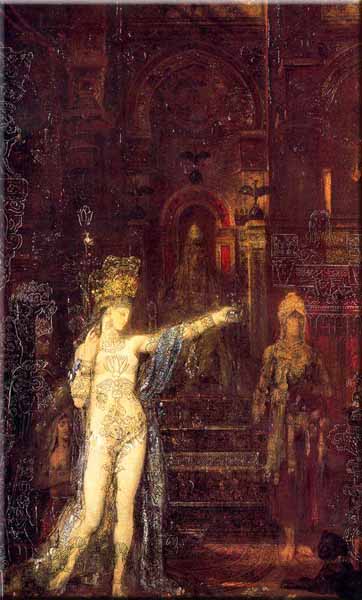Anima: Ten Quotations from Carl Jung

Gustav Moreau
The projection-forming factor is the anima. Wherever she appears in dreams, phantasies or visions, she appears personified, thereby demonstrating that basically she possesses all the outstanding characteristics of a female person.
She is not an invention of the conscious, but a spontaneous production of the unconscious; neither is she a substitute figure for the mother.
On the contrary, there is every likelihood that those numinous attributes which make the Mother imago so dangerously powerful derive from the collective archetype, the anima, which is incarnated anew in every male child.
Spring
1950
Page 5
The realities subsumed under the concept “anima” form an extremely dramatic content of the unconscious.
It is possible to describe this concept in rational, scientific language, but in this way one entirely fails to express its living character.
Therefore I deliberately and consciously give preference to a dramatic, mythological approach and terminology.
In describing the living processes of the soul, such a terminology is not only more expressive but also more exact than abstract scientific terms.
Spring
1950
Page 5
(Inuit Mythology)
The anima is not the soul in the dogmatic sense, not an anima rationalis, which is a philosophical conception, but a natural archetype that satisfactorily sums up all the statements of the unconscious, of the primitive mind, of the history of language and religion. . . .
It is always the a priori element in [a man’s] moods, reactions, impulses, and whatever else is spontaneous in psychic life.
Archetypes of the Collective Unconscious-
Paragraph 57
There is [in man] an imago not only of the mother but of the daughter, the sister, the beloved, the heavenly goddess, and the chthonic Baubo.
Every mother and every beloved is forced to become the carrier and embodiment of this omnipresent and ageless image, which corresponds to the deepest reality in a man.
It belongs to him, this perilous image of Woman; she stands for the loyalty which in the interests of life he must sometimes forego; she is the much needed compensation for the risks, struggles, sacrifices that all end in disappointment; she is the solace for all the bitterness of life.
And, at the same time, she is the great illusionist, the seductress, who draws him into life with her Maya-and not only into life’s reasonable and useful aspects, but into its frightful paradoxes and ambivalences where good and evil, success and ruin, hope and despair, counterbalance one another.
Because she is his greatest danger she demands from a man his greatest, and if he has it in him she will receive it.
Archetypes of the Collective Unconscious
The Syzygy: Anima and Animus,
Paragraph 24
What can a man say about woman, his own opposite?
I mean of course something sensible, that is outside the sexual program, free of resentment, illusion, and theory.
Where is the man to be found capable of such superiority?
Woman always stands just where the man’s shadow falls, so that he is only too liable to confuse the two.
Then, when he tries to repair this misunderstanding, he overvalues her and believes her the most desirable thing in the world.
“Women In Europe” (1927) :
P. 236
You are a slave of what you need in your soul.
The most masculine man needs women, and he is consequently their slave.
Become a woman yourself, and you will be saved from slavery to woman….
It is good for you once to put on women’s clothes: people will laugh at you, but through becoming a woman you attain freedom from women and their tyranny.
The acceptance of femininity leads to completion.
The same is valid for the woman who accepts her masculinity.
Pages 263-264
No man can converse with an animus for five minutes without becoming the victim of his own anima.
Collected Works 7
Anima and Animus
Paragraph 29
circa 750 BC
The first stage–Hawwah, Eve, earth–is purely biological; woman ins equated with the mother and only represents something to be fertilized.
The second stage is still dominated by the sexual eros, but on an aesthetic and romantic level where woman has already acquired some value as an individual.
The third stage raises Eros to the heights of religious devotion and thus spiritualizes him: Hawwah has been replaced by spiritual motherhood.
Finally the fourth stage illustrates…Sapientia…wisdom.
Page 354
1954
<br/
For decades I always turned to the anima when I felt that my emotional behavior was disturbed, and that something had been constellated in the unconscious.
I would then ask the anima: “Now what are you up to? What do you see? I should like to know.”
After some resistance she regularly produced an image. As soon as the image was there, the unrest or sense of oppression vanished.
The whole energy of these emotions was transformed into interest in and curiosity about the image. I would speak with the anima about the images she communicated to me.
Page 187-188
Lorenzo Pasinelli (1629-1700)
Women are a magical force.
They surround themselves with an emotional tension stronger than the rationality of men….
Woman is a very, very strong being, magical.
That is why, I am afraid of women.
From an interview with Jung
Cited in The Anima of the Analyst-Its Development 1992
David Tresan
Page 90
Source






Thank you for compiling this list.
My favorite is:
The acceptance of femininity leads to completion. The same is valid for the woman who accepts her masculinity.